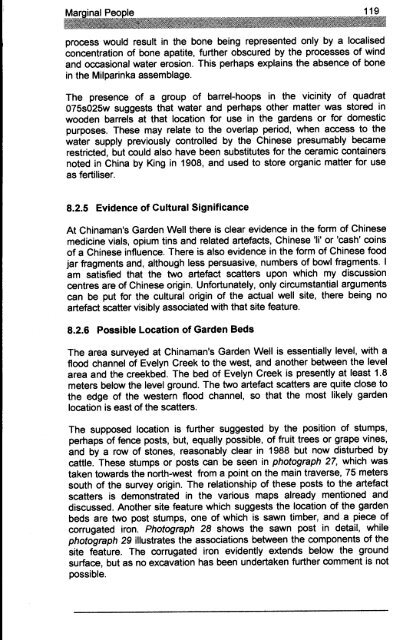Adec Preview Generated PDF File - The Sydney eScholarship ...
Adec Preview Generated PDF File - The Sydney eScholarship ...
Adec Preview Generated PDF File - The Sydney eScholarship ...
Create successful ePaper yourself
Turn your PDF publications into a flip-book with our unique Google optimized e-Paper software.
process would result in the bone being represented only by a localised<br />
concentration of bone apatite, further obscured by the processes of wind<br />
and occasional water erosion. This perhaps explains the absence of bone<br />
in the Milparinka assemblage.<br />
<strong>The</strong> presence of a group of barrel-hoops in the vicinity of quadrat<br />
075s025w suggests that water and perhaps other matter was stored in<br />
wooden barrels at that location for use in the gardens or for domestic<br />
purposes. <strong>The</strong>se may relate to the overlap period, when access to the<br />
water supply previously controlled by the Chinese presumably became<br />
restricted, but could also have been substitutes for the ceramic containers<br />
noted in China by King in 1908, and used to store organic matter for use<br />
as fertiliser.<br />
8.2.5 Evidence of Cultural Significance<br />
At Chinaman's Garden Well there is clear evidence in the form of Chinese<br />
medicine vials, opium tins and related artefacts, Chinese 'Ii' or 'cash' coins<br />
of a Chinese influence. <strong>The</strong>re is also evidence in the form of Chinese food<br />
jar fragments and, although less persuasive, numbers of bowl fragments. I<br />
am satisfied that the two artefact scatters upon which my discussion<br />
centres are of Chinese origin. Unfortunately, only circumstantial arguments<br />
can be put for the cultural origin of the actual well site, there being no<br />
artefact scatter visibly associated with that site feature.<br />
8.2.6 Possible Location of Garden Beds<br />
<strong>The</strong> area surveyed at Chinaman's Garden Well is essentially level, with a<br />
flood channel of Evelyn Creek to the west, and another between the level<br />
area and the creekbed. <strong>The</strong> bed of Evelyn Creek is presently at least 1.8<br />
meters below the level ground. <strong>The</strong> two artefact scatters are quite close to<br />
the edge of the western flood channel, so that the most likely garden<br />
location is east of the scatters.<br />
<strong>The</strong> supposed location is further suggested by the position of stumps,<br />
perhaps of fence posts, but, equally possible, of fruit trees or grape vines,<br />
and by a row of stones, reasonably clear in 1988 but now disturbed by<br />
cattle. <strong>The</strong>se stumps or posts can be seen in photograph 27, which was<br />
taken towards the north-west from a point on the main traverse, 75 meters<br />
south of the survey origin. <strong>The</strong> relationship of these posts to the artefact<br />
scatters is demonstrated in the various maps already mentioned and<br />
discussed. Another site feature which suggests the location of the garden<br />
beds are two post stumps, one of which is sawn timber, and a piece of<br />
corrugated iron. Photograph 28 shows the sawn post in detail, while<br />
photograph 29 illustrates the associations between the components of the<br />
site feature. <strong>The</strong> corrugated iron evidently extends below the ground<br />
surface, but as no excavation has been undertaken further comment is not<br />
possible.




